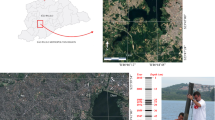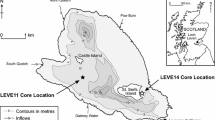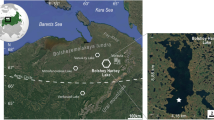Abstract
Arcellaceans have been used as indicators of a variety of paleolimnological conditions including pH, eutrophication, oxygen level, and heavy metal contamination, but there has only been limited application of the group to climate and land-use change research. The limnological evolution of Swan Lake in southwestern Ontario was documented using arcellaceans as proxies, and compared to the results of a palynological analysis, with which it closely correlated. The palynological record documents the rapid disappearance of forest by around 1850 as the area was cleared for agriculture and settlements. The change was characterized by a shift in the palynological record from the Woodland to High Diversity assemblages. Similarly the arcellacean fauna changed from the Pre-European Settlement Assemblage to the distinctive low diversity, stressed environment European Deforestation Assemblage. The introduction of high-yield chemical fertilizers in the post World War II era, and the resultant eutrophication of the lake, was clearly recognizable in the palynological record as indicated by the dramatic increase in the algae Pediastrum (High Nutrient Assemblage). This change in farming practice was also identifiable with arcellacean proxies, as indicated by the appearance of the algalphilic Eutrophication Assemblage. The arcellacean Ecologically Destabilized Assemblage dominated the lake for short intervals during the transition between the Pre-European Settlement and European Deforestation assemblages and again at the transition between the European Deforestation and Eutrophication Assemblages, indicative of periods of ecological destabilization as the lake adjusted to new trophic inputs. A stressed environment arcellacean Ecologically Destabilized Assemblage found in a portion of the core estimated to have been deposited between AD 1350 and AD 1700 may provide evidence of an earlier phase of deforestation associated with Huron Indian agricultural practices. The close correlation between the palynological and arcellacean proxy data clearly demonstrates the potential of arcellaceans as land-use change proxies, and indicates that changes in land-use had an almost immediate impact on the Swan Lake ecosystem. This observation raises concerns about the impact that rapid urbanization is having on the environmentally sensitive Oak Ridges Moraine watershed, of which Swan Lake is a part.
Similar content being viewed by others
References
Anderson T.W. 1997. Early to late Holocene and historical hydro logical changes in the Oak Ridges Moraine, southern Ontario GAC/MAC Assoc. Can. Ann. Meet., Ottawa, May 19–21, 1997, 22:A-3.
Archer W. 1866. Quart. J. Micro Sci 6 new ser.: 185–188.
Asioli A., Medioli F.S. and Patterson R.T. 1996. Thecamoebians as a tool for reconstruction of paleoenvironments in some Italian lakes in the foothills of the southern Alps (Orta, Varese and Canada). J. Foraminif. Res. 26: 248–263.
Barnett P.J., Sharpe D.R., Russell H.A.J., Brennand T.A., Gorrell G., Kenny F.M. et al. 1998. On the origin of the Oak Ridges Moraine. Can J. Earth Sci. 35: 1152–1167.
Bobrov A.A., Charman D.J. and Warner B.G. 1999. Paleoecology of testate amoebae (Protozoa: Rhizopoda) on peatlands in western Russia with special attention to niche separation in closely related taxa. Protist 150: 125–136.
Boudreau R.E.A., Patterson R.T., McKillop W.B. and Dalby A.D. 2001. Non-marine occurrence of the foraminifer Cribroelphidium gunteri in Lake Winnipegosis, Manitoba. J. Foraminif. Res. 32: 108–119.
Burden E.T., McAndrews J.H. and Norris G. 1986. Palynology of Indian and European forest clearance and farming in lake sedi-ment cores from Awenda Provincial Park, Ontario. Can J. Earth Sci. 23: 43–54.
Carpenter W.B. 1861. On the systematic arrangement of the Rhizopoda. Nat. Hist. Rev. 1: 456–472.
Carter H.J. 1856. Notes on the freshwater Infusoria of the island of Bombay. No. 1. Organization. Ann. Mag. Nat. Hist. 18 series 2: 221–249.
Carter H.J. 1864. On freshwater Rhizopoda of England and India. Ann. Mag. Nat. Hist. 13 series 3: 18–39.
Cash J. and Hopkinson J. 1905. The British Freshwater Rhizopoda and Heliozoa.Vol. I: Rhizopoda, part 1. Ray Soc. Publ., London, UK, 151 pp.
Cash J. and Hopkinson J. 1909. The British Freshwater Rhizopoda and Heliozoa.Vol. II: Rhizopoda, part 2. Ray Soc. Publ., London, UK, 166 pp.
Charman D.J., Hendon D. and Woodland W. 2000. The identification of peatland testate amoebae. Technical Guide no. 9. Quat. Res. Assoc., London, UK, 147 pp.
Collins E.S., McCarthy F.M.G., Medioli F.S., Scott D.B. and Honig C.A. 1990. Biogeographic distribution of modern thecamoebians in a transect along the eastern North American coast. In: Hem-leben C., Kaminski M.A., Kuhnt W. and Scott D.B. (eds), Paleoecology, Biostratigraphy, Paleoceanography and Taxonomy of Agglutinated Foraminifera. NATO Adv. Study Inst. Ser. C., pp. 783–791.
Culver S.J. 1987. Foraminifera. In: Broadhead T.W. (ed.), Fossil Prokaryotes and Protists Notes for a Short Course. The Paleon-tological Society and the Cushman Foundation, pp. 169–212.
Dalby A.P., Kumar A., Moore J.M. and Patterson R.T. 2000. Utility of arcellaceans (thecamoebians) as paleolimnological indicators in tropical settings: Lake Sentani, Irian Jaya, Indonesia. J. Foraminif. Res. 30: 135–142.
Dallimore A., Schröder-Adams C.J. and Dallimore S.R. 2000. Holocene environmental history of thermokarst lakes on Rich-ards Island, Northwest Terriotires, Canada: thecamoebians as paleolimnological indicators. J. Paleolim. 23: 261–283.
Davis O.K. 1994. Aspects of Archaeological Palynology: meth-odology and applications. Amer. Assoc. Strat. Palynol. Cont. Ser. 29: 1–221.
Decloître L. 1953. Recherches sur les Rhizopodes thécamoebiens d'A.O.F. (Suite). Faune du Lac Tamna (Senegal). Bull. Inst. Franc Afrique Noire 31: 249–249.
Decloître L. 1956. Les thécamoebiens de l'Eqe (Gröenland): Expéditions Polaires Françaises Missions Paul-Émile Victor VIII, Actual. Sci. Indust. 1242: 1–100.
Deflandre G. 1928. Le genre Arcella Ehrenberg. Morphologie-Biologie. Essai phylogénétique et systématique. Arch. Protistenkunde 64: 152–287.
Deflandre G. 1929. Le genre centropyxis Stein. Arch. Protisten-kunde 67: 323–375.
Dimbleby G.W. 1985. Palynology of Archaeological Sites. Academic Press, New York, USA.
Dumaresq C.G. 1993. The occurrence of arsenic and heavy metal contamination from natural and anthropogenic sources in the Cobalt area of Ontario, MSc, Carleton University and Ottawa-Carleton Geoscience Centre, Ottawa, Ontario, Canada 326 pp.
Ehrenberg C.G. 1830. Organisation, systematic und geographisches Verhätnis der Infusionsthierchen. Berlin Druck. K. Akad. Wiss. 1–108.
Ehrenberg C.G. 1832. Ñber die Entwicklung und Lebensdauer der Infusionsthiere, nebst ferneren Beiträgen zu einer Vergleichung ihrer organischen System: K. Akad. Wiss. Berlin Phys. Abhandl. 1831: 1–154.
Ehrenberg C.G. 1840. Das grössere Infusorienwerke. K. Preuss Akad. Wiss. Berlin Ber. 1840: 198–219.
Ehrenberg C.G. 1843. Verbreitung und Einfluss des mikroskopis-chen Lebens in Sud-ünd Nord Amerika. Akad.Wiss. Berlin Phys. Abhandl. 1841: 291–446.
Ehrenberg C.G. 1848. Ñber eigenthümliche auf den Bämen des Urwaldes in SÑ-Amerika zahlreich lebend mikroskopische oft kieselschalige Organismen. K. Presuu. Akad. Wiss. Berlin Nonatsber. 213–220.
Ehrenberg C.G. 1872. Nachthrag zur Ñbersicht der organischen Atmosphärilien. K. Akad. Wiss. Berlin Phys. Abhandl. 1871: 233–275.
Ellison R. 1995. Paleolimnological analysis of Ullswater using testate amoebae. J. Paleolim. 13: 51–63.
Faegri K. and Iverson J. 1975. Textbook of Pollen Analysis. 3rd edn. Munksgaard, Copenhagen, Denmark.
Fishbein E. and Patterson R.T. 1993. Error-weighed maximum likelihood (EWML): a new statistically based method to cluster quantitative micropaleontological data. J. Paleont. 67: 475–485.
Haman D. 1982. Modern Thecamoebinids (Arcellinida) from the Balize Delta, Louisiana. Trans. Gulf Coast Assoc. Geol. Soc. 32: 353–376.
Hather J.G. 1994. Tropical Archaeobotany: Applications and New Developments. Routledge, London, UK, 270 pp.
Honig C.A. and Scott D.B. 1987. Postglacial stratigraphy and sea-level change in southwestern New Brunswick. Can. J. Earth Sci. 24: 354–364.
Howard K.W.F., Eyles N., Smart P.J., Boyce J.I., Gerber R.E., Salvatori L. et al. 1996. The Oak Ridges Moraine of southern Ontario: a ground-water resource at risk. Geosci. Can. 153–171.
Kent W.S. 1880. A manual of the influsioria: including a descrip-tion of all known Flagellate, Ciliate, and Tentaculiferous Protozoa, British and Foreign, and an account of the organization and affinities of the sponges. Bogue, London 1: 1–472.
Kumar A. and Dalby A.P. 1998. Identification key for Holocene lacustrine arcellacean (thecamoebian) taxa. Palaeontol. Electr. 1 http: / / palaeo-electronica.org /: 1–39.
Kumar A. and Patterson R.T. 2000. Arcellaceans (Thecamoebians): new tools for monitoring long and short term changes in lake bottom acidity. Envir. Geol. 39: 689–697.
Lamarck J.B. 1816. Histoire naturelle des animaux sans vertèbres. Verdièrer, Paris 2: 1–568.
Leidy J. 1874. Notice of some new fresh-water rhizopods. Acad. Nat. Sci. Phil. Proc. 3: 77–79.
Leidy J. 1879. Notice of some rhizopods. Acad. Nat. Sci. Phil. Proc. 3: 155–157.
Leidy J. 1879. Freshwater rhizopods of North America. US Geol. Survey Terr. 12: 1–324.
McAndrews J.H. 1988. Human disturbance of North American forests and grasslands: The fossil pollen record. In: Huntley B. and Webb III T. (eds), Vegetation History. Kluwer Academic Publishers, Dordrecht, The Netherlands, pp. 673–697.
McAndrews J.H. 1994. Pollen diagrams of southern Ontario ap-plied to archaeology. In: McDonald R.I. (ed.), Great Lakes Archaeology and Paleoecology: Explaining Interdisciplinary Initiatives for the Nineties. Quat. Sci. Inst. Univ., Waterloo, pp. 179–195.
McAndrews J.H. and Boyko-Diakonow M. 1989. Pollen analysis of varved sediment at Crawford Lake, Ontario. Evidence for Indian and European farming. In: Fulton R.J. (ed.), Quaternary Geology of Canada and Greenland. Geology of Canada No. 1. Geol. Surv. Can., Canada, pp. 528–530.
McCarthy F.M.G., Collins E.S., McAndrews J.H., Kerr H.A., Scott D.B. and Medioli F.S. 1995. A comparison of postglacial arcella-cean ('thecamoebian' and pollen succession in Atlantic Canada, illustrating the potential of arcellaceans for paleoclimatic recon-struction. J. Paleont. 69: 980–993.
Medioli F.S. and Scott D.B. 1983. Holocene Arcellacea (Thecamoebians) from eastern Canada: Cushman found. Foraminif. Res. Spec. Publ. 21: 1–63.
Medioli F.S. and Scott D.B. 1988. Lacustrine thecamoebians (main-ly arcellaceans) as potential tools for palaeolimnological interpretations. Palaeogeogr. Palaeoclimatol. Palaeoecol. 62: 361–386.
Medioli F.S., Scott D.B. and Abbott B.H. 1987. A case study of protozoan interclonal variability: taxonomic implications. J. Foraminif. Ref. 17: 28–47.
Medioli F.S., Scott D.B., Collins E.S. and McCarthy F.M.G. 1990. Fossil thecamoebians: present status and prospects for the future. In: Hemleben C., Kaminski M.A., KuhntW. and Scott D.B. (eds), Paleoecology, Biostratigraphy, Paleoceanography and Tax-onomy of Agglutinated Foraminifera. NATO Adv. Study Inst. Ser. C., pp. 813–840.
Ogden C.G. and Hedley R.H. 1980. An Atlas of Freshwater Testate Amoeba. British Museum (Natural History). Oxford University Press, Oxford, UK, 222 pp.
Ogden C.G. and Ellison R.L. 1988. The value of the organic cement matrix in the identification of the shells of fossil testate amoeba. J. Micropalaeont. 7: 233–240.
Patterson R.T. and Fishbein E. 1989. Re-examination of the statistical methods used to determine the number of point counts needed for micropaleontological quantitative research. J. Paleont. 63: 245–248.
Patterson R.T. and Kumar A. 2000a. Assessment of arcellacea (thecamoebian) assemblages, species and strains as contaminant indicators in variably contaminated James Lake, northeastern Ontario. J. Foraminif. Res. 30: 310–320.
Patterson R.T. and Kumar A. 2000b. Use of arcellacea to gauge levels of pollution and remediation of industrially polluted lakes. In: Martin R.E. (ed.), Environmental Micropaleontology, v 15 of Topics in Geobiology. Kluwer Academic/Plenum Publication, pp. 257–278.
Patterson R.T. and Kumar A. 2002. A review of current testate rhizopid (thecamoebian) research in Canada. Palaeogeogr. Palaeoclimatol. Palaeoecol. 180: 225–251.
Patterson R.T., MacKinnon K.D., Scott D.B. and Medioli F.S. 1985. Arcellaceans (Thecamoebians) in small lakes of New Brunswick and Nova Scotia: modern distribution and Holocene stratigraphic changes. J. Foraminif. Ref. 15: 114–137.
Patterson R.T., Barker T. and Burbidge S.M. 1996. Arcellaceans (thecamoebians) as proxies of arsenic and mercury contamina-tion in northeastern Ontario lakes. J. Foraminif. Ref. 26: 172–183.
Penard E. 1890. Études sur les Rhizopodes d'eau douce. Soc. Phys. Histoire Nat. Genève Mem. 31: 1–230.
Penard E. 1899. Les Rhizopodes de faune profonde dans le lac Léman. Rev. Suisse Zool. 7: 1–142.
Penard E. 1902. Faune Rhizopodique du Bassin du Léman. Henry Kundig, Genève, Switzerland.
Reinhardt E.D., Dalby A.P., Kumar A. and Patterson R.T. 1998. Utility of arcellacean morphotypic variants as pollution in-dicators in mine tailing contaminated lakes near Cobalt, Ontario, Canada. Micropaleontology 44: 1–18.
Riley J.L. and Mohr P. 1994. The natural heritage of southern Ontario's settled landscapes: a review of conservation and restoration ecology for land-uuse and landscape planning. Ontario Min. Nat. Res. Aurora 1–77.
Ruzicka E. 1982. di subfossilen Testaceen des Krottensees (Salzburg, Österreich). Limnologica 14: 49–88.
Schlumberger P. 1845. Observations sur quelques nouvelles es-pèces d'Infusoires de la famille des Rhizopodes. Ann. Sci. Nat. B. Zool. Ser. 3: 254–256.
Schmarda L.K. 1871. Zoologie: Band I. Braumüller, Wien, Austria.
Schönborn W.S. 1984. Studies on remains of Testacea in cores of the Great Woryty Lake (NE-Poland). Limnologica (Berlin) 16: 185–190.
Schultze F.E. 1877. Rhizopodenstudien VI. Arch. Mikroscopische Anatomie 13: 9–30.
Scott D.B. and Hermelin J.O.R. 1993. A device for precision splitting of micropaleontological samples in liquid suspension. J. Paleont. 67: 151–154.
Scott D.B. and Medioli F.S. 1983. Testate rhizopods in Lake Erie: modern distribution and stratigraphic implications. J. Paleont. 57: 809–820.
Scott D.B., Medioli F.S. and Schafer C.T. 2001. Monitoring of Coastal Environments Using Foraminifera and Thecamoebian Indicators. Cambridge University Press, Cambridge, USA, 192 pp.
Sharpe D.R., Dyke L.D., Hinton M.J., Pullan S.E., Russell H.A.J., Brennand T.A. et al. 1996. Groundwater prospects in the Oak Ridge Moraine area, southern Ontario: application of regional geological models. Curr. Res. 1996-E, Geol. Surv. Can. 181–190.
Siebold, von C.T.E. 1845. Wirbellose Thiere: part 1. In: von Siebold C.T.E. and von Stannius H. (eds), Lehr. Vergleich. Anatomie., pp. 1–679.
Stein, von S.F.N. 1859. Ñber die ihm aus eigener Untersuchung bekannt gewordenen Susswässer-Rhizopoden. K. Ceska Spolec-nosti Nauk, Prague (K. Böhm. Geselll. Wiss. Abhandl.) Ser. 5 10: 41–43.
Wallich G.C. 1864. On the extent, and some of the principal causes, of structural variation among the difflugian rhizopods. Ann. Mag. Nat. Hist. Ser. 3 13: 215–245.
Wallis S.D. 1993. Sonar profiling: a subbottom study of Gillies, Peterson, and Crosswise lakes, Ontario, B.Sc., Carleton Uni versity, Ottawa, Ontario, Canada 40 pp.
Author information
Authors and Affiliations
Corresponding author
Rights and permissions
About this article
Cite this article
Patterson, R.T., Dalby, A., Kumar, A. et al. Arcellaceans (thecamoebians) as indicators of land-use change: settlement history of the Swan Lake area, Ontario as a case study. Journal of Paleolimnology 28, 297–316 (2002). https://doi.org/10.1023/A:1021621622090
Issue Date:
DOI: https://doi.org/10.1023/A:1021621622090




